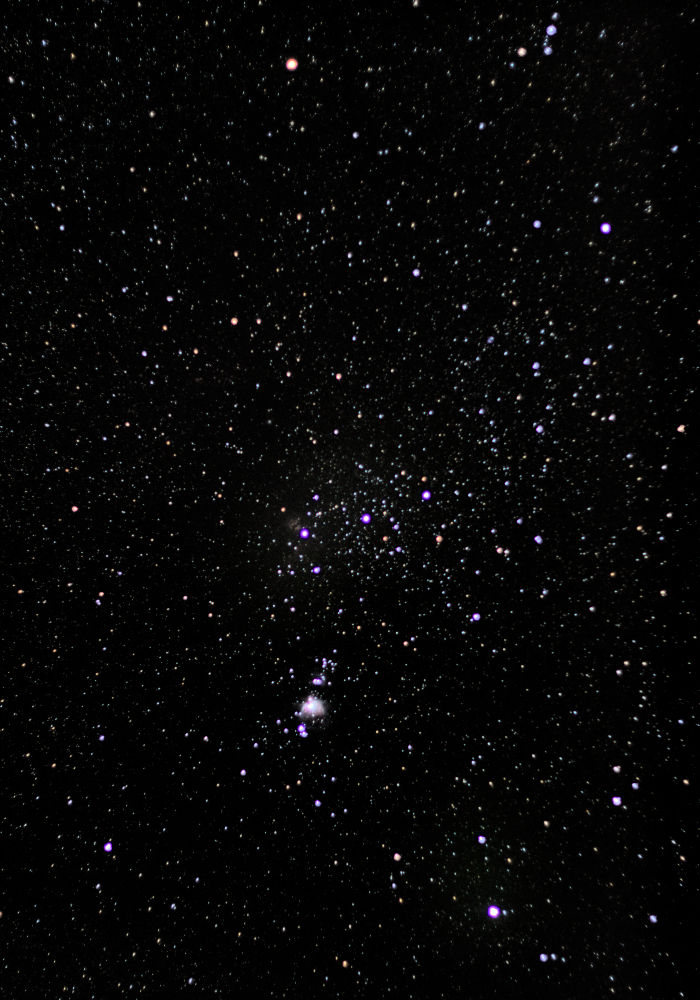Photography
Related: About this forumOrion
Just another image stacking experiment from within the city, so not the best conditions, but again I'm amazed by the variety of star colors. Shot with 50mm f/1.8 lens, 200 1.6-second exposures at ISO 1600, stacked with Sequator:

SheltieLover
(57,073 posts)Ty for sharing!
NoRoadUntravelled
(2,626 posts)Thanks for posting this.
Ohiogal
(32,083 posts)I do see Orion.... when ever I happen to be out at night and the sky is full of stars, Orion is always the first thing I look for. I have no idea why. But, you did a great job! TY for sharing!
3Hotdogs
(12,414 posts)My Qanonnonies placed a secret message in sky by arranging the 5 stars to the right of the blur in the center of your damn picture. It refers to the five messengers who are gonna explain how to stop Biden from ruining America on Jan. 20th. Each messenger was gonna issue part of the message and only my club members will get all five messages and we will know what to do on January 21st.
Know everybody knows.
Thanks a lot pal.
lagomorph777
(30,613 posts)It was recorded in Chinese histories; was actually visible in daylight. It was also recorded in rock carvings and other media, around the world.
And, yes, I know it exploded long before 1054 (1344 years before that); the light reached Earth in 1054.

jimlup
(7,968 posts)Betelgeuse is the left shoulder, Rigel is the right knee (our perspective.) Betelgeuse is getting ready to go supernova at the end of its life. Rigel is a hot post main sequence star burning hot and blue with a super hot helium burning core.
Nice picture, especially from within the city!
SergeStorms
(19,204 posts)llashram
(6,265 posts)MLAA
(17,329 posts)yonder
(9,676 posts)How is that done without using some sort of mechanical tracker to prevent blurring? Or is it done in the software somehow?
William Seger
(10,779 posts)The exposures are too short to show any star trails, and the software aligns and combines the images. I used Sequator, which is freeware. I like it because it has an optional function to reduce the effects of light pollution, which really helps where I'm shooting, but another popular free one is Deep Sky Stacker.
yonder
(9,676 posts)William Seger
(10,779 posts)Last edited Wed Nov 25, 2020, 02:46 PM - Edit history (1)
This was shot with Canon T6s, an entry-level DSLR, and a $100 50mm f/1.8 lens (Canon's "nifty fifty," quite a bargain and it's great for portraits) which is not a telephoto lens. The 18-55mm kit lens works well for stacking, too, but it can only open up to f/4.5, so the 50mm is "faster" and seems to show more color in the stars. I also have a wide-angle 10-18mm lens, which will be great for the Milky Way when I (eventually) get under some clear, dark sky, and a 55-250mm telephoto lens that I hope to use to get some nice nebula shots. Unfortunately, I just found out about this stacking technique now that the weather is getting too cold to be outside for long, but it's so much fun I'll have to keep experimenting!
lagomorph777
(30,613 posts)I remember trying to manually compensate a star tracker for astrophotography with my dad. My photos turned out horribly - all wavery. Stacking seems like a great cure for that problem!
William Seger
(10,779 posts)Coming out of the stacker, there's a lot of subtle detail on the low end of the histogram which our eyes can't distinguish readily, so it has to be "stretched" out with a histogram adjustment. The trick is to do that without making the pixels that are supposed to be black too gray, so I sacrificed a little detail to keep this background dark. There are YouTube videos -- of course -- that explain it pretty well. I can't remember life before YouTube. ![]()
liberalla
(9,262 posts)Thank you!